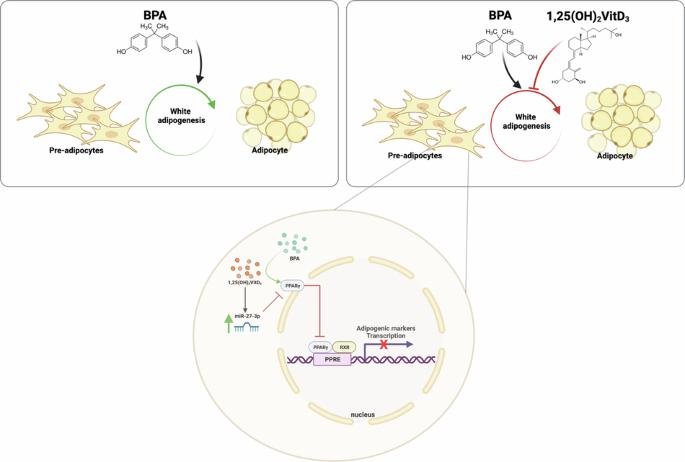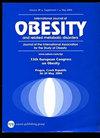1,25‑Dihydroxyvitamin D3 mitigates the adipogenesis induced by bisphenol A in 3T3-L1 and hAMSC through miR-27-3p regulation
IF 4.2
2区 医学
Q1 ENDOCRINOLOGY & METABOLISM
引用次数: 0
Abstract
Endocrine-disrupting compounds, including bisphenol A (BPA), may promote obesity influencing basal metabolic rate and shifting metabolism towards energy storage. The role of 1,25‑Dihydroxyvitamin D3 (VitD) in counteracting adipogenesis is still a matter of debate. Thus, the current study aims to investigate whether and how VitD exposure during adipogenesis could prevent the pro-adipogenic effect of BPA in two adipocyte models, mouse 3T3-L1 cell line and human adipose-derived mesenchymal stem cells (hAMSC). 3T3-L1, mouse pre-adipocytes and human adipose-derived mesenchymal stem cells (hAMSC) were treated with VitD (10−7 M) and BPA (10−8 M and 10−9 M), alone or in combination, throughout the differentiation in mature adipocytes. Cellular lipid droplet accumulation was assessed by Oil Red O staining, mRNA and protein expression of key adipogenic markers, transcription factors, and cytokines were investigated by RT-qPCR and WB, respectively. miRNAs involved in the regulation of adipogenic transcription factors were evaluated by RT-qPCR, and highly potent steric-blocking oligonucleotides (miRNA inhibitors) were used to modulate miRNAs expression. Pre-adipocytes express VitD receptor (VDR) in basal condition, but during the differentiation process VDR expression reduces if not stimulated by the ligand. VitD significantly decreases lipid accumulation, with a consequent reduction in adipogenic marker expression, and counteracts the pro-adipogenic effect of BPA in 3T3-L1 and hAMSC during differentiation. This effect is associated to the increased expression of miR-27a-3p and miR-27b-3p. The blocking of miR-27a-3p and miR-27b-3p through miRNA inhibitors prevents the anti-adipogenic effect of VitD in both cell models. These results suggest that in cultured 3T3-L1 and hAMSC VitD induces an anti-adipogenic effect and prevents BPA pro-adipogenic effect by triggering at least in part epigenetic mechanisms involving miR-27-3p.


1,25-二羟维生素 D3 通过调控 miR-27-3p 减轻双酚 A 诱导的 3T3-L1 和 hAMSC 脂肪生成
目的包括双酚 A(BPA)在内的干扰内分泌的化合物可能会促进肥胖,影响基础代谢率并使新陈代谢转向能量储存。1,25-二羟维生素 D3(VitD)在抑制脂肪生成方面的作用仍存在争议。因此,本研究旨在探讨在两种脂肪细胞模型(小鼠 3T3-L1 细胞系和人脂肪间充质干细胞(hAMSC))中,脂肪生成过程中暴露于 VitD 是否以及如何阻止双酚 A 的促脂肪生成效应。方法在成熟脂肪细胞的整个分化过程中,单独或联合使用 VitD(10-7 M)和 BPA(10-8 M 和 10-9 M)处理 3T3-L1、小鼠前脂肪细胞和人脂肪间充质干细胞(hAMSC)。用油红 O 染色法评估细胞脂滴的积累,用 RT-qPCR 和 WB 分别检测关键脂肪生成标志物、转录因子和细胞因子的 mRNA 和蛋白表达。结果 前期脂肪细胞在基础状态下会表达 VitD 受体(VDR),但在分化过程中,如果没有配体的刺激,VDR 的表达会降低。在 3T3-L1 和 hAMSC 的分化过程中,VitD 能明显降低脂质积累,从而减少脂肪生成标志物的表达,并抵消双酚 A 的促脂肪生成作用。这种效应与 miR-27a-3p 和 miR-27b-3p 的表达增加有关。结论:这些结果表明,在培养的 3T3-L1 和 hAMSC 中,VitD 通过触发至少部分涉及 miR-27-3p 的表观遗传学机制,诱导了抗致脂作用,并阻止了 BPA 的促致脂作用。
本文章由计算机程序翻译,如有差异,请以英文原文为准。
求助全文
约1分钟内获得全文
求助全文
来源期刊

International Journal of Obesity
医学-内分泌学与代谢
CiteScore
10.00
自引率
2.00%
发文量
221
审稿时长
3 months
期刊介绍:
The International Journal of Obesity is a multi-disciplinary forum for research describing basic, clinical and applied studies in biochemistry, physiology, genetics and nutrition, molecular, metabolic, psychological and epidemiological aspects of obesity and related disorders.
We publish a range of content types including original research articles, technical reports, reviews, correspondence and brief communications that elaborate on significant advances in the field and cover topical issues.
 求助内容:
求助内容: 应助结果提醒方式:
应助结果提醒方式:


